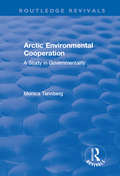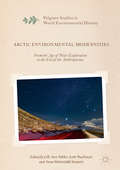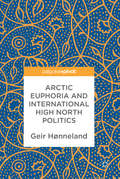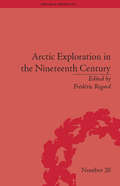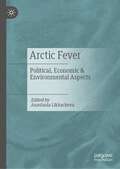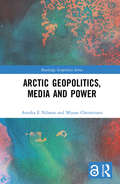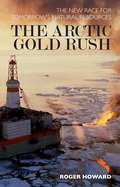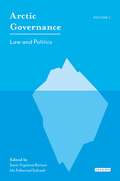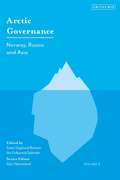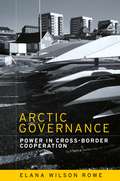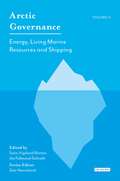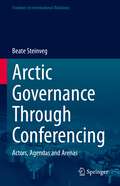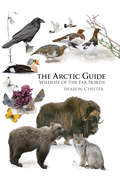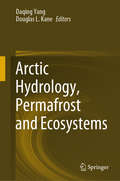- Table View
- List View
Arctic Environmental Cooperation: A Study in Governmentality
by Monica TennbergThis title was first published in 2000: The book analyses the development of arctic environmental cooperation since the late 1980s until the establishment of the Arctic Council in 1996. The study is based on the discourse analysis of statement, documents and interviews by the different actors in the cooperation. In this book, the problem of the environment is seen as a problem of order: it is a problem of ordering relations among related actors, of ordering priorities of action and of ordering relations between different institutional arrangements locally, regionally and internally. Three discourses were found in the cooperation: discourses of sovereignty, knowledge and development. In the discourse of sovereignty, the development of relations between state and indigenous peoples in terms of international environmental cooperation is central. In the discourse of knowledge, the different forms of knowledge and the role of different producers of knowledge in cooperation has been discussed. The discourse of development focuses on the idea of sustainable development and its applications in defining the future of the Circumpolar North and the activities of the Arctic Council. The arctic cooperation can be understood as a regional effort to make an order of sustainability into practice.
Arctic Environmental Cooperation: A Study in Governmentality
by Monica TennbergThis title was first published in 2000: The book analyses the development of arctic environmental cooperation since the late 1980s until the establishment of the Arctic Council in 1996. The study is based on the discourse analysis of statement, documents and interviews by the different actors in the cooperation. In this book, the problem of the environment is seen as a problem of order: it is a problem of ordering relations among related actors, of ordering priorities of action and of ordering relations between different institutional arrangements locally, regionally and internally. Three discourses were found in the cooperation: discourses of sovereignty, knowledge and development. In the discourse of sovereignty, the development of relations between state and indigenous peoples in terms of international environmental cooperation is central. In the discourse of knowledge, the different forms of knowledge and the role of different producers of knowledge in cooperation has been discussed. The discourse of development focuses on the idea of sustainable development and its applications in defining the future of the Circumpolar North and the activities of the Arctic Council. The arctic cooperation can be understood as a regional effort to make an order of sustainability into practice.
Arctic Environmental Modernities: From the Age of Polar Exploration to the Era of the Anthropocene (Palgrave Studies in World Environmental History)
by Lill-Ann Körber Scott MacKenzie Anna Westerståhl StenportThis book offers a diverse and groundbreaking account of the intersections between modernities and environments in the circumpolar global North, foregrounding the Arctic as a critical space of modernity, where the past, present, and future of the planet’s environmental and political systems are projected and imagined. Investigating the Arctic region as a privileged site of modernity, this book articulates the globally significant, but often overlooked, junctures between environmentalism and sustainability, indigenous epistemologies and scientific rhetoric, and decolonization strategies and governmentality. With international expertise made easily accessible, readers can observe and understand the rise and conflicted status of Arctic modernities, from the nineteenth century polar explorer era to the present day of anthropogenic climate change.
Arctic Euphoria and International High North Politics
by Geir HønnelandThis pivot describes the ups and downs of Norwegian High North politics since the end of the Cold War. It considers how political interest in the Arctic has been growing rapidly in the international community as states stake their claim to areas of the continental shelf in the Arctic Ocean, and focuses on Russia’s actions, as the Arctic state with the longest shoreline and the only one outside NATO. The author argues that among the Western countries, Norway has the most extensive experience in tackling Russia in the Arctic, and the neighbourhood with the Russian Bear invariably shapes foreign policy, notably in matters of security, and how foreign policy concerns are intertwined with economic motives, be that hopes of access to the big Russian market or to the oil and gas fields on the Russian Arctic shelf. To achieve the combined goal of security and business, the Norwegian Government has regularly orchestrated “Arctic waves” to direct the attention of local, national and international politicians and businesses to the alleged opportunities of the North. In this book, the author takes us through “the Great Barents Awakening” of the 1990s, “the Great High North Enchantment” of the early 2000s and recent years’ “Arctic wave” in Norwegian foreign policy.
Arctic Euphoria and International High North Politics
by Geir HønnelandThis pivot describes the ups and downs of Norwegian High North politics since the end of the Cold War. It considers how political interest in the Arctic has been growing rapidly in the international community as states stake their claim to areas of the continental shelf in the Arctic Ocean, and focuses on Russia’s actions, as the Arctic state with the longest shoreline and the only one outside NATO. The author argues that among the Western countries, Norway has the most extensive experience in tackling Russia in the Arctic, and the neighbourhood with the Russian Bear invariably shapes foreign policy, notably in matters of security, and how foreign policy concerns are intertwined with economic motives, be that hopes of access to the big Russian market or to the oil and gas fields on the Russian Arctic shelf. To achieve the combined goal of security and business, the Norwegian Government has regularly orchestrated “Arctic waves” to direct the attention of local, national and international politicians and businesses to the alleged opportunities of the North. In this book, the author takes us through “the Great Barents Awakening” of the 1990s, “the Great High North Enchantment” of the early 2000s and recent years’ “Arctic wave” in Norwegian foreign policy.
Arctic Exploration in the Nineteenth Century: Discovering the Northwest Passage (Empires in Perspective)
by Frédéric RegardFocusing on nineteenth-century attempts to locate the northwest passage, the essays in this volume present this quest as a central element of British culture.
Arctic Exploration in the Nineteenth Century: Discovering the Northwest Passage (Empires in Perspective)
by Frédéric RegardFocusing on nineteenth-century attempts to locate the northwest passage, the essays in this volume present this quest as a central element of British culture.
Arctic Fever: Political, Economic & Environmental Aspects
by Anastasia LikhachevaThis book explores the Arctic as a rapidly evolving phenomenon in international affairs of a rising number of stakeholders. For decades, Arctic studies used to be an affair of a relatively narrow group of experts from northern countries. This time is over due to a new Chinese Arctic policy, as well as growing regional interests from South Korea, Singapore, India and Japan. Contributors reflect on new roles for the Arctic region: both as a playground for the old school nation state competition and even confrontation, and a new source for international cooperation in energy, logistics and natural sciences. Climate change, political tensions and economic competition make Arctic a hotter venue of international relations. This new Arctic fever, studied through a comparative analysis of different regional agendas, especially with a focus on the US–China–Russia triangle, represents the main subject of our book, which will be of interest to scholars of geopolitics, of climate change, and of 21st century energy economics.
The Arctic Fox
by Holly WebbEvie is so excited to spend her Christmas holiday in Lapland – they're going to visit Santa, go on a reindeer sleigh ride and watch the Northern Lights. She's even dreamed about seeing her favourite animal – the arctic fox. Evie's parents say this is unlikely, though, as hunting has left the species endangered. But when she hears a strange whining noise in the middle of the night, she follows the sounds and discovers a little arctic fox caught in a trap. Can Evie rescue him in time? A magical wintry tale from best-selling author Holly Webb. For fans of Michael Morpurgo and THE SNOW FOAL, this is the perfect book to snuggle up with and enjoy this winter.
Arctic Geopolitics, Media and Power (Routledge Geopolitics Series)
by Annika Nilsson E. Miyase ChristensenArctic Geopolitics, Media and Power provides a fresh way of looking at the potential and limitations of regional international governance in the Arctic region. Far-reaching impacts of climate change, its wealth of resources and potential for new commercial activities have placed the Arctic region into the political limelight. In an era of rapid environmental change, the Arctic provides a complex and challenging case of geopolitical interplay. Based on analyses of how actors from within and outside the Arctic region assert their interests and how such discourses travel in the media, this book scrutinizes the social and material contexts within which new imaginaries, spatial constructs and scalar preferences emerge. It places ground-breaking attention to shifting media landscapes as a critical component of the social, environmental and technological change. It also reflects on the fundamental dilemmas inherent in democratic decision making at a time when an urgent need for addressing climate change is challenged by conflicting interests and growing geopolitical tensions. This book will be of great interest to geography academics, media and communication studies and students focusing on policy, climate change and geopolitics, as well as policy-makers and NGOs working within the environmental sector or with the Arctic region. The Open Access version of this book, available at http://www.tandfebooks.com/doi/view/10.4324/9780367189822 has been made available under a Creative Commons Attribution-Non Commercial-No Derivatives 4.0 license.
Arctic Geopolitics, Media and Power (Routledge Geopolitics Series)
by Annika Nilsson E. Miyase ChristensenArctic Geopolitics, Media and Power provides a fresh way of looking at the potential and limitations of regional international governance in the Arctic region. Far-reaching impacts of climate change, its wealth of resources and potential for new commercial activities have placed the Arctic region into the political limelight. In an era of rapid environmental change, the Arctic provides a complex and challenging case of geopolitical interplay. Based on analyses of how actors from within and outside the Arctic region assert their interests and how such discourses travel in the media, this book scrutinizes the social and material contexts within which new imaginaries, spatial constructs and scalar preferences emerge. It places ground-breaking attention to shifting media landscapes as a critical component of the social, environmental and technological change. It also reflects on the fundamental dilemmas inherent in democratic decision making at a time when an urgent need for addressing climate change is challenged by conflicting interests and growing geopolitical tensions. This book will be of great interest to geography academics, media and communication studies and students focusing on policy, climate change and geopolitics, as well as policy-makers and NGOs working within the environmental sector or with the Arctic region. The Open Access version of this book, available at http://www.tandfebooks.com/doi/view/10.4324/9780367189822 has been made available under a Creative Commons Attribution-Non Commercial-No Derivatives 4.0 license.
The Arctic Gold Rush: The New Race for Tomorrow's Natural Resources
by Roger HowardAn exploration of the political significance of the Arctic's vast untapped wealth of natural resources, and a gripping account of the race to exploit them On August 2, 2007, a Russian submarine captured world headlines by making a dangerous journey to the bottom of the Arctic seabed and planting a metal, rustfree national flag more than 14,000 feet beneath the North Pole. The aim was to assert Russia's legal sovereignty over a region whose importance had only recently started to become apparent as its melting ice had made, or was expected to make, vast natural resources open to exploitation.The latest estimates are that the region holds around 13% of the world's undiscovered oil and as much as 30% of undiscovered natural gas reserves that would be hugely profitable for any country that managed to secure control over them. Gold, platinum, copper, and other precious metals have also been found along the coast. Neighboring countries - Russia, the United States, Canada, Denmark, and Norway - are already doing everything they can to mark out new borders. The ensuing political disagreements over the issue are already rife. In particular, games of political intrigue between Moscow and Washington are being played out in the region. But as the world's resources become increasingly scarce and valuable, could the scramble for Arctic resources become violent? Could a "War for the Arctic" be fought?Praise for The Oil Hunters:"The Dramatic Days of oil exploration in the first half of the 20th century are narrated in gripping fashion by Roger Howard." -The Spectator"A fascinating story for anyone interested in one of today's main economic problems: How to reduce the hundreds of billions that Americans spend every year to import oil...the book is packed with intrepid geologists, risk-averse business people, hardup Mideast rulers and ingenious promoters- all concerned with driving up profits."-The Associated Press
The Arctic Gold Rush: The New Race for Tomorrow's Natural Resources
by Roger HowardAn exploration of the political significance of the Arctic's vast untapped wealth of natural resources, and a gripping account of the race to exploit them On August 2, 2007, a Russian submarine captured world headlines by making a dangerous journey to the bottom of the Arctic seabed and planting a metal, rustfree national flag more than 14,000 feet beneath the North Pole. The aim was to assert Russia's legal sovereignty over a region whose importance had only recently started to become apparent as its melting ice had made, or was expected to make, vast natural resources open to exploitation.The latest estimates are that the region holds around 13% of the world's undiscovered oil and as much as 30% of undiscovered natural gas reserves that would be hugely profitable for any country that managed to secure control over them. Gold, platinum, copper, and other precious metals have also been found along the coast. Neighboring countries - Russia, the United States, Canada, Denmark, and Norway - are already doing everything they can to mark out new borders. The ensuing political disagreements over the issue are already rife. In particular, games of political intrigue between Moscow and Washington are being played out in the region. But as the world's resources become increasingly scarce and valuable, could the scramble for Arctic resources become violent? Could a "War for the Arctic" be fought?Praise for The Oil Hunters:"The Dramatic Days of oil exploration in the first half of the 20th century are narrated in gripping fashion by Roger Howard." -The Spectator"A fascinating story for anyone interested in one of today's main economic problems: How to reduce the hundreds of billions that Americans spend every year to import oil...the book is packed with intrepid geologists, risk-averse business people, hardup Mideast rulers and ingenious promoters- all concerned with driving up profits."-The Associated Press
Arctic Governance: Law and Politics (Arctic Governance Ser. #Vol. 1)
by Svein Vigeland Rottem Ida Folkestad SoltvedtThe Polar North is known to be home to large gas and oil reserves and its position holds significant trading and military advantages, yet the territorial boundaries of the region remain ill-defined. In the 21st century the Arctic continent is undergoing profound change. As the sea ice melts, a result of accelerating climate change, global governance has become vital. The Polar North is known to be home to large gas and oil reserves and its position holds significant trading and military advantages, yet the territorial boundaries of the region remain ill-defined. In the 21st century the Arctic continent is undergoing profound change. As the sea ice melts, a result of accelerating climate change, global governance has become vital. In this first of three volumes, the latest research and analysis from the world's leading Arctic research body - the Fridtjof Nansen Institute - is brought together for the first time. Arctic Governance: Law and Power investigates the political contexts and international tensions surrounding the actions of nation states, focusing especially on the disputes which have emerged where European, American and Russian interests compete directly. Skillfully delineating policy in the region, and analyzing the legal and political consequences of treaty agreements, Arctic Governance will become an indispensable handbook to contemporary International Relations concerning the Polar North.
Arctic Governance: Norway, Russia and Asia (Arctic Governance)
by Svein Vigeland Rottem Ida Folkestad SoltvedtThe Polar North is known to be home to large gas and oil reserves and its position holds significant trading and military advantages, yet the maritime boundaries of the region remain ill-defined. In the twenty-first century the Arctic is undergoing profound change. As the sea ice melts, a result of accelerating climate change, global governance has become vital. In this, the third of three volumes, the latest research and analysis from the world's leading Arctic research body - the Fridtjof Nansen Institute - is brought together for the first time. Arctic Governance: Norway, Russia and Asia investigates the foreign policy discourses of Arctic governance, specifically as regarding international relations and competing interests between Norway, Russia and various Asian states.
Arctic governance: Power in cross-border cooperation (Current Practices in Ophthalmology)
by Elana Wilson RoweWhile the Arctic is sometimes presented in media debate as the potential site of the ‘next Great Race’ or even military conflict, the striking feature of the region is its largely cooperative and peaceful nature. This book seeks to understand better how Arctic cross- border cooperation is developed, sustained and periodically contested against a backdrop of power relations.
Arctic Governance: Law and Politics
by Ida Folkestad Soltvedt Svein Vigeland RottemThe Polar North is known to be home to large gas and oil reserves and its positionholds signifi cant trading and military advantages, yet the maritime boundaries of the region remain ill-defined. In the twenty-first century the Arctic is undergoing profound change. As the sea ice melts, a result of accelerating climate change, global governance has become vital. In this first of three volumes, the latest research and analysis from the Fridtjof Nansen Institute, the world's leading Arctic research body, is brought together. Arctic Governance: Law and Politics investigates the legal and political order of the Polar North, focusing on governance structures and the Law of the Sea. Are the current mechanisms at work effective? Are the Arctic states' interests really clashing, or is the atmosphere of a more cooperative nature? Skilfully delineating policy in the region and analysing the consequences of treaty agreements, Arctic Governance's uncovering of a rather orderly 'Arctic race' will become an indispensable contribution to contemporary International Relations concerning the Polar North.
Arctic Governance: Energy, Living Marine Resources and Shipping (Arctic Governance Ser.)
by Ida Folkestad Soltvedt Svein Vigeland Rottem Geir HønnelandThe Polar North is known to be home to large gas and oil reserves and its position holds significant trading and military advantages, yet the maritime boundaries of the region remain ill-defined. In the twenty-first century the Arctic is undergoing profound change. As the sea ice melts, a result of accelerating climate change, global governance has become vital. In this first of three volumes, the latest research and analysis from the Fridtjof Nansen Institute, the world's leading Arctic research body, is brought together. Arctic Governance: Law and Politics investigates the legal and political order of the Polar North, focusing on governance structures and the Law of the Sea. Are the current mechanisms at work effective? Are the Arctic states' interests really clashing, or is the atmosphere of a more cooperative nature? Skilfully delineating policy in the region and analysing the consequences of treaty agreements, Arctic Governance's uncovering of a rather orderly 'Arctic race' will become an indispensable contribution to contemporary International Relations concerning the Polar North.
Arctic Governance: Energy, Living Marine Resources and Shipping
by Ida Folkestad Soltvedt Svein Vigeland Rottem Geir HønnelandThe Polar North is known to be home to large gas and oil reserves and its position holds significant trading and military advantages, yet the maritime boundaries of the region remain ill-defined. In the twenty-first century the Arctic is undergoing profound change. As the sea ice melts, a result of accelerating climate change, global governance has become vital. In this first of three volumes, the latest research and analysis from the Fridtjof Nansen Institute, the world's leading Arctic research body, is brought together. Arctic Governance: Law and Politics investigates the legal and political order of the Polar North, focusing on governance structures and the Law of the Sea. Are the current mechanisms at work effective? Are the Arctic states' interests really clashing, or is the atmosphere of a more cooperative nature? Skilfully delineating policy in the region and analysing the consequences of treaty agreements, Arctic Governance's uncovering of a rather orderly 'Arctic race' will become an indispensable contribution to contemporary International Relations concerning the Polar North.
Arctic Governance: Norway, Russia and Asia (Arctic Governance)
The Polar North is known to be home to large gas and oil reserves and its position holds significant trading and military advantages, yet the maritime boundaries of the region remain ill-defined. In the twenty-first century the Arctic is undergoing profound change. As the sea ice melts, a result of accelerating climate change, global governance has become vital. In this, the third of three volumes, the latest research and analysis from the world's leading Arctic research body - the Fridtjof Nansen Institute - is brought together for the first time. Arctic Governance: Norway, Russia and Asia investigates the foreign policy discourses of Arctic governance, specifically as regarding international relations and competing interests between Norway, Russia and various Asian states.
Arctic Governance Through Conferencing: Actors, Agendas and Arenas (Frontiers in International Relations)
by Beate SteinvegThis book examines the functions of conferences within Arctic governance, as a third dimension between sovereign states and formalized cooperative arrangements. It analyzes conferences against the background of three main empirical topics. Firstly, the functions of conferences for different actor groups, both Arctic rights holders and emerging non-Arctic state actors claiming stakeholder status. From this, the book also analyzes how conferences contribute to altering the actor composition of Arctic governance as a whole. Secondly, conferences as agenda setting arenas – whether conference activities can contribute to influencing the broader agenda in the region, and conferences as arenas for agenda setting – whether participants can bring with them topics that are picked up and brought into other processes. Thirdly, the book considers the space for conferences within broader governance architectures, as links between units in the regime complex.The book further presents an in-depth case study of the two largest conferences on Arctic issues: the Arctic Frontiers and Arctic Circle Assembly. It illustrates the diverse functions conferences can have for elements within a broader governance system, beyond serving as meeting places and networking arenas. Therefore, it is a must-read for researchers, students, and policy-makers interested in a better understanding of Arctic governance in particular, and International Relations in general.
The Arctic Guide: Wildlife of the Far North
by Sharon ChesterThe Arctic Guide presents the traveler and naturalist with a portable, authoritative guide to the flora and fauna of earth's northernmost region. Featuring superb color illustrations, this one-of-a-kind book covers the complete spectrum of wildlife—more than 800 species of plants, fishes, butterflies, birds, and mammals—that inhabit the Arctic’s polar deserts, tundra, taiga, sea ice, and oceans. It can be used anywhere in the entire Holarctic region, including Norway’s Svalbard archipelago, Siberia, the Russian Far East, islands of the Bering Sea, Alaska, the Canadian Arctic, and Greenland. Detailed species accounts describe key identification features, size, habitat, range, scientific name, and the unique characteristics that enable these organisms to survive in the extreme conditions of the Far North. A color distribution map accompanies each species account, and alternative names in German, French, Norwegian, Russian, Inuit, and Inupiaq are also provided. Features superb color plates that allow for quick identification of more than 800 species of plants, fishes, butterflies, birds, and mammals Includes detailed species accounts and color distribution maps Covers the flora and fauna of the entire Arctic region
The Arctic Guide: Wildlife of the Far North
by Sharon ChesterThe Arctic Guide presents the traveler and naturalist with a portable, authoritative guide to the flora and fauna of earth's northernmost region. Featuring superb color illustrations, this one-of-a-kind book covers the complete spectrum of wildlife—more than 800 species of plants, fishes, butterflies, birds, and mammals—that inhabit the Arctic’s polar deserts, tundra, taiga, sea ice, and oceans. It can be used anywhere in the entire Holarctic region, including Norway’s Svalbard archipelago, Siberia, the Russian Far East, islands of the Bering Sea, Alaska, the Canadian Arctic, and Greenland. Detailed species accounts describe key identification features, size, habitat, range, scientific name, and the unique characteristics that enable these organisms to survive in the extreme conditions of the Far North. A color distribution map accompanies each species account, and alternative names in German, French, Norwegian, Russian, Inuit, and Inupiaq are also provided. Features superb color plates that allow for quick identification of more than 800 species of plants, fishes, butterflies, birds, and mammals Includes detailed species accounts and color distribution maps Covers the flora and fauna of the entire Arctic region
Arctic Hydrology, Permafrost and Ecosystems
by Daqing Yang Douglas L. KaneThis book provides a comprehensive, up-to-date assessment of the key terrestrial components of the Arctic system, i.e., its hydrology, permafrost, and ecology, drawing on the latest research results from across the circumpolar regions. The Arctic is an integrated system, the elements of which are closely linked by the atmosphere, ocean, and land. Using an integrated system approach, the book’s 30 chapters, written by a diverse team of leading scholars, carefully examine Arctic climate variability/change, large river hydrology, lakes and wetlands, snow cover and ice processes, permafrost characteristics, vegetation/landscape changes, and the future trajectory of Arctic system evolution. The discussions cover the fundamental features of and processes in the Arctic system, with a special focus on critical knowledge gaps, i.e., the interactions and feedbacks between water, permafrost, and ecosystem, such as snow pack and permafrost changes and their impacts on basin hydrology and ecology, river flow, geochemistry, and energy fluxes to the Arctic Ocean, and the structure and function of the Arctic ecosystem in response to past/future changes in climate, hydrology, and permafrost conditions. Given its scope, the book offers a valuable resource for researchers, graduate students, environmentalists, managers, and administrators who are concerned with the northern environment and resources.
